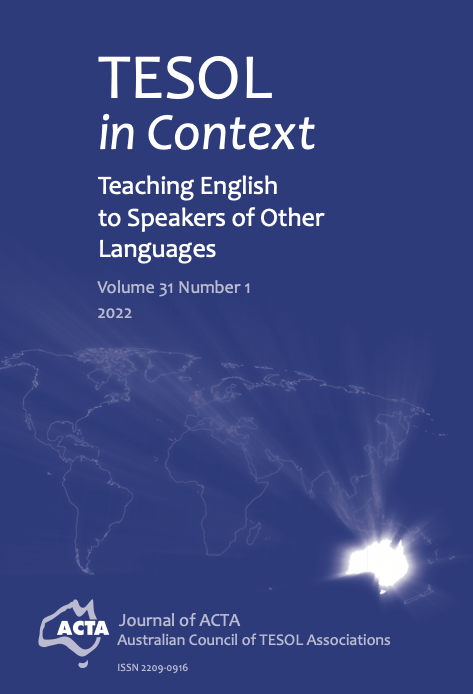Science and EAL teachers’ perspectives and practices in building word knowledge in implementing the new Victorian EAL curriculum
DOI:
https://doi.org/10.21153/tesol2022vol31no1art1533Keywords:
EAL curriculum, linguistically responsive instruction, science, vocabulary, teacher collaborationAbstract
The recent implementation of The Victorian Curriculum F-10: EAL requires content teachers who teach EAL students to be familiar with the revised EAL curriculum for the purposes of planning and developing approaches to assist learners’ development in English. In the literature and in curriculum frameworks, word knowledge is considered an important aspect of EAL students’ learning. However, little is known about what pedagogical practices teachers across the curriculum perceive as being important, and use, in developing EAL students’ vocabulary. In this study, we investigated linguistically responsive vocabulary teaching in a Year 7 science class. Our aim was to elucidate teachers’ perceptions and practices in teaching vocabulary in science. The qualitative case study drew on principles of linguistically responsive instruction (LRI), which refers to practices for meeting the needs of students in culturally and linguistically diverse classrooms. Analysis of interview and classroom data from an EAL teacher and a science teacher revealed a range of LRI practices for developing word knowledge based on understanding the distinction between conversational and academic language, language learning principles, responsive teacher talk, plurilingual awareness, and the importance of social interaction for learners. We offer recommendations for a whole school approach to LRI, adaptation to online LRI, and curriculum development.
Metrics
References
Australian Curriculum. (n.d.). Meeting the needs of students for whom English is an additional language or dialect. Retrieved 20/11/2021 from https://www.australiancurriculum.edu.au/resources/student-diversity/meeting-the-needs-of-students-for-whom-english-is-an-additional-language-or-dialect/
Australian Institute for Teaching and School Leadership (n.d.) https://www.aitsl.edu.au/teach/standards
Brown, B., & Ryoo, K. (2008). Teaching science as a language: A content-first approach to science teaching. Journal of Research in Science Teaching, 45(5), 529–553.
Cink R. B. and Song Y., (2016), Appropriating scientific vocabulary in chemistry laboratories: a multiple case study of four community college students with diverse ethno-linguistic backgrounds, Chem. Educ. Res. Pract., 17(3), 604–617.
Creese, A. (2010). Content-focused classrooms and learning English: How teachers collaborate. Theory into practice, 49(2), 99-105. http://dx.doi.org/10.1080/00405841003626494.
Cummins, J. (2000). Language, power and pedagogy. Bilingual children in the crossfire. Clevedon, UK: Multilingual Matters.
de Jong, E. J., & Harper, C. A. (2005). Preparing mainstream teachers for English-language learners: is being a good teacher good enough? Teacher Education Quarterly, 32(2), 101. https://link.gale.com/apps/doc/A133566590/AONE?u=monash&sid=bookmark-AONE&xid=ae301866
de Jong, E. J., Harper, C. A., & Coady, M. R. (2013). Enhanced knowledge and skills for elementary mainstream teachers of English language learners. Theory into Practice, 52(2), 89-97. https://doi.org/10.1080/00405841.2013.770326
Edwards, S. (2014). Supporting English language learners: New Zealand secondary mainstream teachers’ knowledge and use of recommended teaching resources and strategies. New Zealand Journal of Educational Studies, 49(1), 43-58, http://www.springer.com/education+%26+language/journal/40841
Gallagher, C. E., & Haan, J. E. (2017). University faculty beliefs about emergent multilinguals and linguistically responsive instruction. TESOL Quarterly, 52(2), 304-330. https://doi.org/10.1002/tesq.399
Gibbons, E. (2002). Scaffolding language, scaffolding learning: Teaching second language learners in the mainstream classroom. Portsmouth, NH: Heinemann.
Hammond, J. (2012). Hope and challenge in The Australian Curriculum: Implications for EAL students and their teachers. Australian Journal of Language and Literacy, 35(1), 223-240, https://www.alea.edu.au/resources/australian-journal-of-language-and-literacy- ajll
Halliday, M. A. K. (1978). Language as social semiotic: The social interpretation of language meaning. London: Edward Arnold
Haworth, P. (2009). The quest for a mainstream EAL pedagogy. Teachers College Record, 111(9), 2179–2208, http://www.tcrecord.org/
Jefferson, G. (2004). Glossary of transcript symbols with an introduction. In G. Lerner (Ed.), Conversation analysis: Studies from the first generation. John Benjamins.
Krashen, S. D. (1982). Principles and practices in second language acquisition. Pergamon.
Lucas, T., Villegas, A. M., & Freedson-Gonzalez, M. (2008). Linguistically responsive teacher education: Preparing classroom teachers to teach English language learners. Journal of Teacher Education, 59(4), 361-373. https://doi.org/10.1177/0022487108322110
Mehan, H. (1979). Learning lessons: Social organisation in the classroom. Cambridge University Press.
Mohr, K.J., & Mohr, E.S. (2007, February). Extending English-Language learners’ classroom interactions using the response protocol. The Reading Teacher, 60(5), 440-450.
Rees, S.W., Kind, V., & Newton D. (2018). Can language focussed activities improve understanding of chemical language in non-traditional students? Chem. Educ. Res. Pract., 19, 755-766.
Reid, J.M. (1987). The learning style preferences of ESL students. TESOL Quarterly 21(1), 87–111.
Schön, D. (1983). The reflective practitioner: How professionals think in action. Basic Books.
Sibold, C. (2011). Building English language learners’ academic vocabulary: Strategies & tips. Multicultural Education, 18(2), 24–28.
Stoddart, T., Pinal, A., Latzke, M., & Canaday, D. (2002). Integrating inquiry science and language development for English language learners. Journal of Research in Science Teaching, 39, 664-687.
Victorian Curriculum and Assessment Authority (VCAA) (n.d.). Literacy Teaching toolkit. Retrieved 25/01/2022 from https://www.education.vic.gov.au/school/teachers/teachingresources/discipline/english/literacy/speakinglistening/Pages/litfocusvocab.aspx
Victorian Curriculum and Assessment Authority. (n.d.). Victorian Curriculum F-10: English as an Additional Language. Retrieved 20/11/2021 from https://victoriancurriculum.vcaa.vic.edu.au/english/english-as-an-additional-language-eal
Victorian Curriculum and Assessment Authority. (n.d.). Victorian Curriculum F-10: Science. Retrieved 20/11/2021 from
https://victoriancurriculum.vcaa.vic.edu.au/science/introduction/rationale-and-aims
Downloads
Published
Issue
Section
License
Copyright (c) 2023 TESOL in Context

This work is licensed under a Creative Commons Attribution-ShareAlike 4.0 International License.






